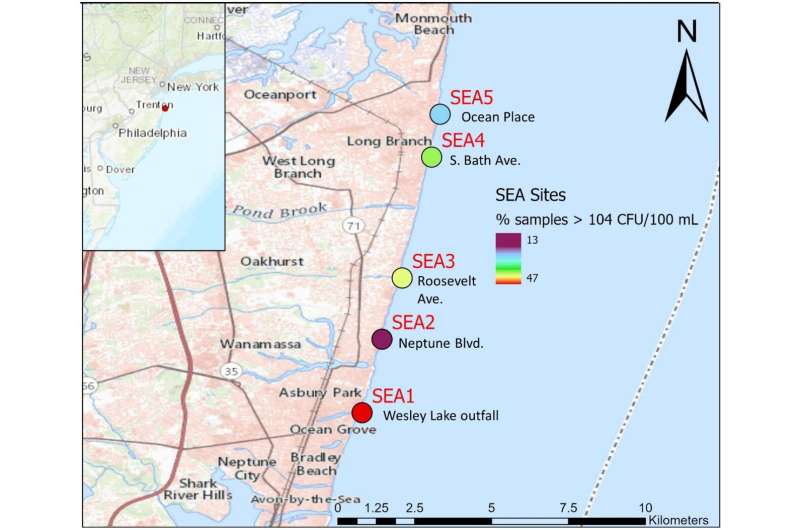This article has been reviewed according to Science X's editorial process and policies. Editors have highlighted the following attributes while ensuring the content's credibility:
fact-checked
proofread
Study finds rain-driven microbial pollution persists at surfing beaches in colder months

Surfers at beaches where stormwater drainage pipes discharge into the ocean risk catching more than waves on a rainy day. Monmouth University researchers studying the influence of weather and ocean conditions on microbial pollution found that within 6–24 hours of moderate rainfall, enterococcus bacteria levels exceeded state health safety standards about half the time at these beaches. While rain is a known driver of illness-causing microbial pollution at New Jersey beaches, this was the first peer-reviewed study to formally investigate the linkage.
The research is published in the journal Environmental Monitoring and Assessment.
Endowed Professor of Marine Science Jason Adolf and Specialist Professor Jeff Weisburg of Monmouth University's Biology Department collected water samples with students on dry days and following storms at five Monmouth County beaches with outflow pipes in 2019 and 2020. The research was conducted both in the summer bathing season—when the state monitors pollution levels weekly—and from September–May, which is not a time period regularly monitored by the state. Although the throngs of beachgoers largely vanish after Labor Day, the fall and winter months are considered prime surfing season for the Jersey Shore, and its waters remain crowded with riders taking advantage of hurricane swells.
"Without a system on the beach to warn them, surfers could unknowingly be exposed to bacteria that can cause respiratory infections, nausea, abdominal pain and fevers," said Dr. Weisburg, whose research focus is immunology and disease. "Since the restrictions on which beaches you're allowed to surf at are lifted in the off season, surfers should take advantage of the other beaches open to them and steer clear of outfall pipes during and after rains."
The samples were tested for enterococcus levels and checked for relationships with data for three important drivers: precipitation, which transports animal waste and other pollutants to beaches via stormwater discharges; water temperature, which determines how easy it is for bacteria to thrive; and tide stage, which can control whether the pollutants are diluted or concentrated.
Model accurately predicts microbial pollution based on environmental data
The research found that rainfall within 6–24 hours of sampling and higher water temperatures were the best predictors of high enterococcus counts, although exceedances of the state regulatory threshold of 104 colony-forming units (CFU) per 100 mL seawater were found in all seasons—even in seas as cold as 44 degrees F, following rainy periods. Although not an explicit part of this study, observations during sampling suggested that these bacteria spikes subsided quickly at these sites, within one or two days of occurring.
The researchers created a model that could predict the likelihood of bacteria spikes at the sampling sites with accuracy based on data for rainfall accumulations, water temperature and water levels. When the model focused on sites having stormwater drainage in the surf zone, its predictions that levels would exceed the state threshold were correct 69% of the time; it was a perfect 100% when it predicted levels would stay safely below the threshold.
Adolf said a model of this type, if expanded statewide, could be used to augment the state's own system for monitoring water quality and advising bathers when the ocean is unsafe. New Jersey regularly samples on Mondays and only follows up with tests on Tuesdays or beyond if it detects a CFU count above 104.
The five sampling sites offered case studies in how the setup of outfalls could impact the results. A site where overflow water drained from Wesley Lake in Asbury Park had the highest percentage of samples above the threshold. The percentage was lowest at Neptune Boulevard in Deal, where the water drained into a sandy dune area that essentially filtered it before it reached the ocean. The results were more consistent at Roosevelt Avenue in Deal, and South Bath Avenue and Ocean Place in Long Branch, where the pipes all drained stormwater into the surf zone area.
The researchers also used the model generated in this study to "back cast" enterococcus levels at the same beaches using about 20 years of historical hourly rainfall, water temperature, and water level data. The output was used to test the efficacy of different sampling scenarios.
"Over the long term at the sites we studied, you're going to detect about one in seven exceedance events if you're only sampling one out of seven days because the nature of rainfall is random and the response of microbial pollution is rapid," Adolf said. "If it happens to rain on the weekend or early Monday, you're going to get a lot of exceedances when you measure on Monday. But if it rains on Tuesday through Saturday, the beaches we studied are likely to exceed enterococcus levels within 24 hours and will probably be clear by the following Monday. We recognize the logistical challenges to daily sampling, but our research suggests you can supplement weekly monitoring with modeling that predicts the water's safety based on environmental parameters which are already being measured all the time."
The study was co-authored by Monmouth graduates Kelly Hanna and Victoria Lohnes, with research contributions by Monmouth graduates Maria Riley, Skyler Post, Ariel Zavala, and Erin Conlon. Associate Professor of Geography Geoffrey Fouad made important editorial contributions to the paper.
More information: Jason E. Adolf et al, Enterococcus exceedances related to environmental variability at New Jersey ocean beaches, Environmental Monitoring and Assessment (2022). DOI: 10.1007/s10661-022-10788-0
Provided by Monmouth University





















